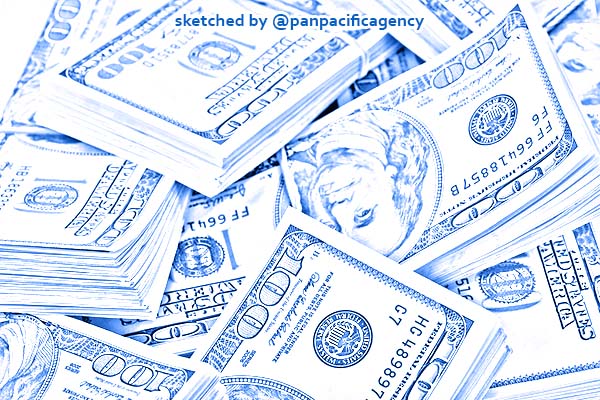[Analytics] Global economy faces a ‘$2 trillion hit’

Many bundle of US 100 dollars bank notes. Image: Flickr. Sketched by the Pan Pacific Agency.
The United Nations has warned that the global economy faces “a US$2 trillion hit” in a “doomsday scenario” now that the World Health Organisation has declared a worldwide pandemic. As the Covid-19 disease spreads across the planet and the battle switches from China to Europe and the United States, concerns are growing that global growth will be wiped out as consumer demand evaporates. Gordon Watts specially for the Asia Times.
“From an economic perspective, the key issue is not just the number of cases of Covid-19, but the level of disruption to economies from containment measures,” Ben May, the head of macro research at Oxford Economics, said in a report this week.
“Widespread lockdowns such as those imposed by China have been enacted in some virus hotspots [such as Italy],” he added, pointing out that these measures could cause panic and weaken the global economy even more.
First detected in Wuhan last December, the virus quickly spread across the world’s second-largest economy from the capital of Hubei province before infecting more than 110,000 people in at least 110 countries in less than three months.
According to the WHO, the death toll has now reached more than 4,000.
Already the economic impact has been immense with worldwide markets tanking as major institutions and banks cut growth forecasts.
In a March report, the Organisation for Economic Co-operation and Development, or OECD, announced it had downgraded its 2020 predictions for almost all countries. Then on Monday, the UN Conference on Trade and Development went even further and predicted that global GDP could take “a $2 trillion hit.”
“One ‘doomsday scenario’ in which the world economy grew at only 0.5%, would involve ‘a $2 trillion hit’ to gross domestic product,” Richard Kozul-Wright, of the Globalization and Development Strategies at UNCTAD, said, adding that collapsing oil prices had been “a contributing factor to the sense of unease and panic.”
On the day that the UNCTAD rolled out its report, world markets went into meltdown. Hysteria over plunging oil prices and supply-chain chaos added to the uncertainty.
“Few countries [are] unlikely to be left unscathed by the outbreak’s financial ramifications,” Kozul-Wright said in a statement. “Apart from the tragic human consequences of the Covid-19 epidemic, the economic uncertainty it has sparked will likely cost the global economy [at least] $1 trillion in 2020,” the study stated before revealing that “doomsday scenario.”
Dwindling consumer demand will not only act as a brake but drag down further GDP growth while the speed of the spread of the coronavirus has caught economists and analysts struggling to keep up.
The UBS Group summed up the situation perfectly with the tag line “we are revising … everything” in a note released on Thursday.
“To take on board the spread of the virus (additional consumption pull-back and supply chain disruption across multiple countries), the slow pace of normalization in China, the collapse of oil prices, and the additional disruption we expect over the next four-to-six weeks, we have revised our forecasts for countries as well as all major asset classes,” the Swiss multinational investment bank said.
“In the pandemic scenario, we expect global growth in 2020 to fall to 0.8% (with 18 of 28 countries in recession),” UBS added.
As for Asia, if China, Europe and the United States catch influenza, the region will end up on life-support.
South Korea and Japan are battling their own outbreaks while the ASEAN countries of Indonesia, Vietnam, Cambodia, Singapore, Malaysia, Brunei, Philippines, Laos, Myanmar and Thailand are bracing for the economic fallout.
After suffering early infections in January, countries such as Singapore, Vietnam and the Phillippines appear to have contained the epidemic while new cases in Thailand have declined.
But the business impact will still be severe.
“During the SARS outbreak in 2002 and 2003, tourism from China to countries such as Japan, South Korea, Malaysia, Singapore and the Philippines dropped by as much as 90% before rebounding the following year. But regional economies have become much more dependent on Chinese tourism since then. Today, visitors from China make up around 40% of all tourist arrivals in the region, up from less than 20% before SARS,” Anne Oeking, an economist at the ASEAN+3 Macroeconomic Research Office in Singapore, said.
“Even a relatively short-lived embargo on Chinese travel will have a much bigger impact this time around. Tourism’s contribution to economies of the region has increased almost everywhere since the early 2000s. In 2018, the tourism industry was estimated to have contributed more than 30% of Cambodia’s GDP, and more than 20% for Thailand and the Philippines. A drop in visitor arrivals from China and other countries [would be] damaging for the ASEAN+3 region,” she wrote on the East Asia Forum website.
Looking at the broader issues for major Asia-Pacific nations, the outlook is just as chilling.
“Among major economies outside of China, the OECD forecasts the largest downward growth revisions in countries deeply interconnected to China, especially South Korea, Australia and Japan,” Stephanie Segal and Dylan Gerstel, of the Center for Strategic and International Studies, a think tank based in Washington, said.
“Major European economies will experience dislocations as the virus spreads and countries adopt restrictive responses that curb manufacturing activity at regional hubs. As a result of depressed activity, the United Nations projects that foreign direct investment flows could fall between 5% and 15% to their lowest levels since the global financial crisis [between 2008 and 2009],” they wrote in a commentary.
In the meantime, that “$2 trillion hit” might end up looking rather conservative if the Covid-19 outbreak continues to wreak havoc across the planet.